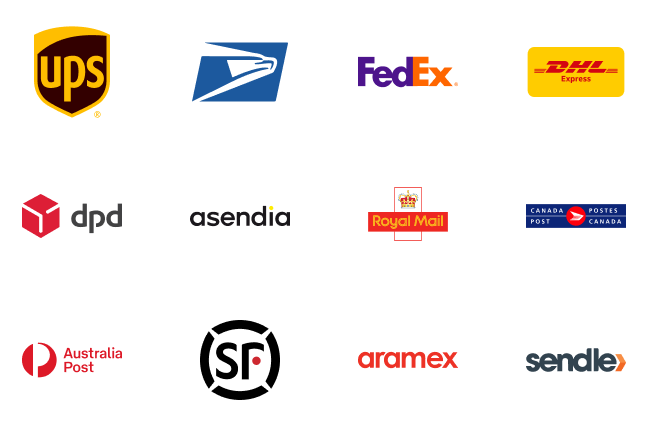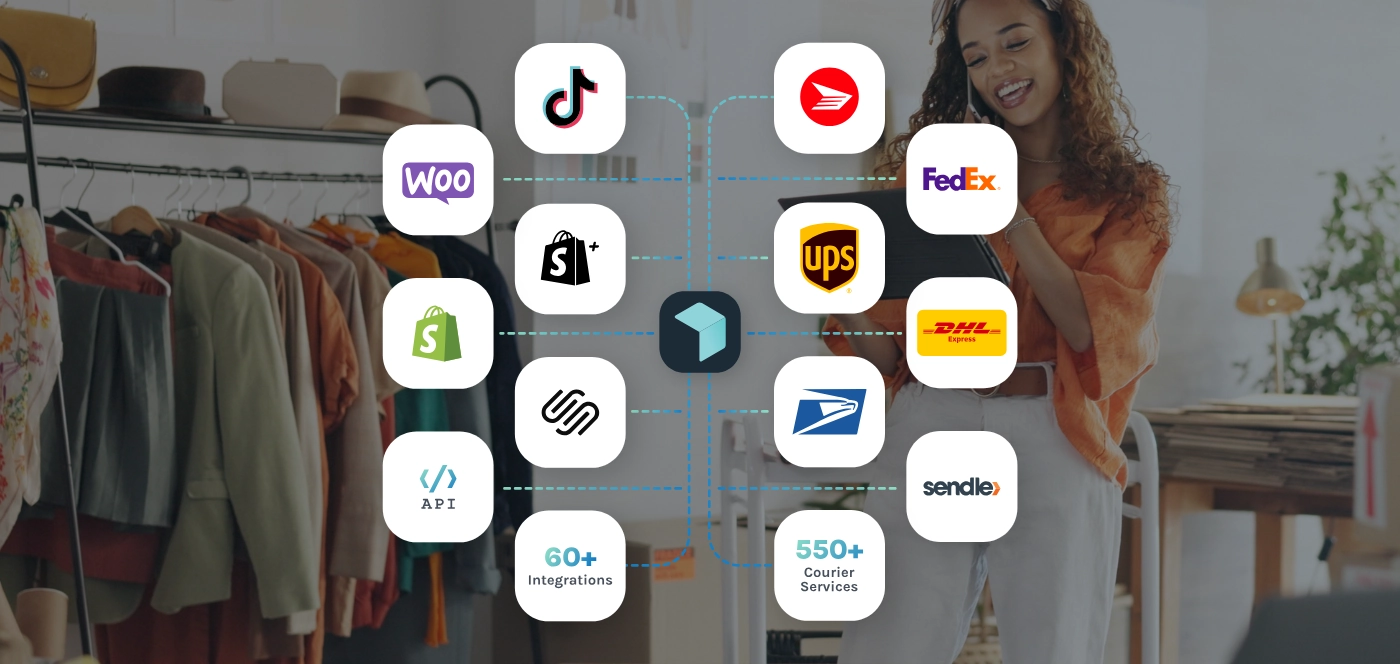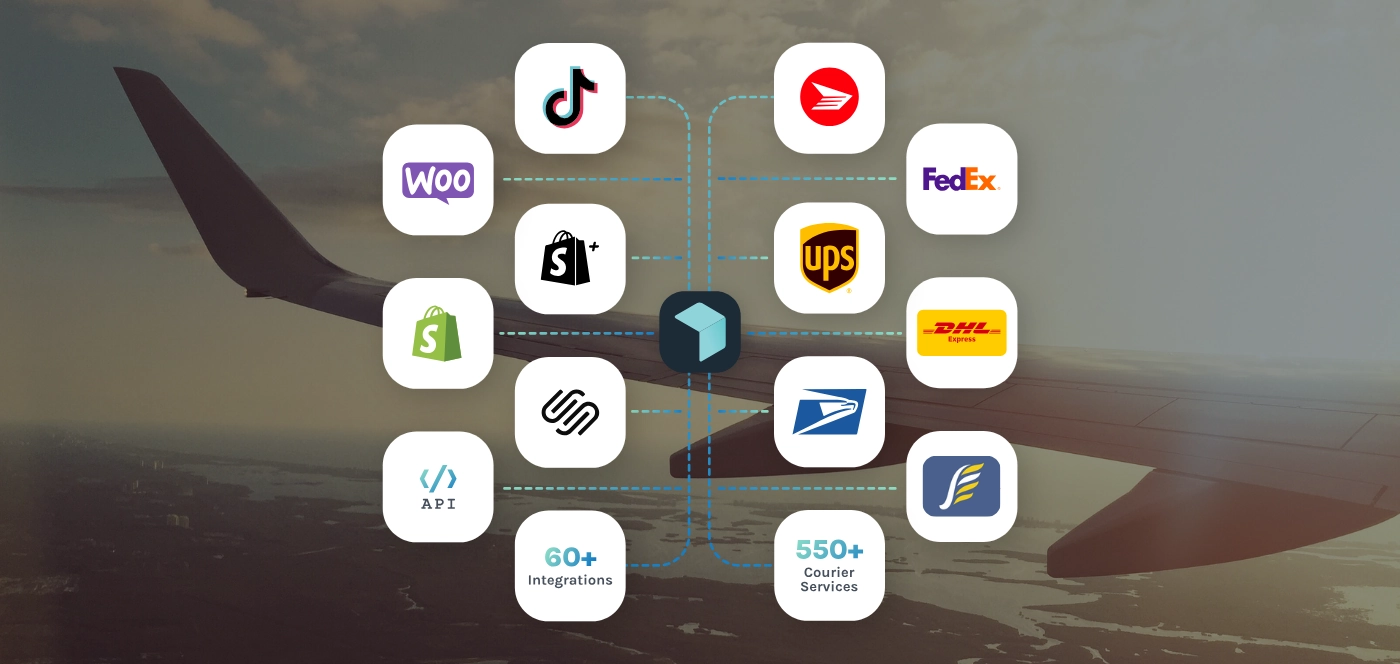Latest Section 321 Updates (May 2, 2025):
This is an evolving story originally published on February 2, 2025.
It has been frequently updated by our global cross-border shipping experts on February 8, March 14, April 8 and again most recently on May 2, 2025, in line with the official removal of the "de minimis" duty-free treatment for Chinese sourced goods being imported into the U.S.
While this is an ever-evolving space as trade policy and political tensions rise, we will continue to monitor and update this resource with the latest information as a go-to reference for eCommerce brands that sell and import retail items into the United States.
Current De Minimis Status & 2025 Change Timeline
For easy reference, the current timeline of changes and status of the proposed amendments to Section 321 de minimis exemption in 2025 are:
1. On Saturday, February 1, 2025, President Trump issued an executive order eliminating the popular De Minimis exemption for all imports from China. This includes Chinese manufactured goods and items that are predominantly made with Chinese parts.
2. This major change came into effect on Tuesday, February 4, 2025, and marked a significant shift in how online brands import retail products into the US. Notably, where the origin of the product now matters more than the location from which it is shipped.
3. In the latest development, President Trump then issued an amendment to the original executive order on February 7th, temporarily reinstating the De Minimis exemption for Chinese goods. The De Minimis exemption is also in place for other countries.
4. It is important to note that this reinstatement is likely temporary (rumored and later confirmed to be between 60-90 days) and will only remain in effect until the Secretary of Commerce notifies President Trump that "adequate systems are in place" to account for the new process of collecting tariff revenue at the border.
5. Once fully enforced, all shipments will be subject to tariffs and require full customs documentation irresiectove of their value, which is expected to increase paperwork processing times by 30–50% and raise administrative costs for businesses.
6. As of April 2, 2025, President Trump confirmed by an executive order that the popular sub-$800 Section 321 'de minimis' duty exemption rule is ending for Chinese-made goods from May 2, meaning it is important to understand the country of origin for your products and inventory.
7. On May 2, 2025, all goods imported to the United States with a Chinese origin (including those shipped from Hong Kong) are now subject to the full Chinese tariffs, irrespective of their value and if they previously would have enetered the U.S. duty-free under the less than $800 low value shipment de minimis section with T86 entry.
The impact of this proposed and impending change is significant. Leading to a large increase in the number of eCommerce retailers and online sellers seeking US-based eCommerce Fulfillment and tech-enabled 3PL options.
It also highlights the importance of implementing the right cross-border shipping tools, like Easyship's all-in-one shipping software, which allows brands to automatically calculate import tariffs, taxes, and duties and offer transparent import calculations inside your store's checkout.
Understanding Section 321 & U.S. De Minimis Exemption
Before diving into the nuts and bolts of tariffs, you should grasp the fundamentals of Section 321—a provision within U.S. customs law that, until recently, allowed you to import goods valued at or under $800 duty-free.
This allowance is commonly called the U.S. De Minimis Value, a threshold introduced to streamline international trade and reduce administrative burdens for low-value shipments.
By keeping shipments below $800, you could typically avoid formal customs entries and extra fees, a strategy that eCommerce sellers around the world leveraged to provide fast, duty-free deliveries to American consumers.
However, as you’ll see below, recent executive orders by President Trump and changes to the Tariff Act have redefined how this once-generous de minimis rule applies—currently for China and Hong Kong but possibly for all countries in the near future or if your imports are subject to specific tariff laws.
Snapshot of Changes to Section 321: Before & After Comparison
We hear you. This is a long article that details a range of complex tax, duty and government trade policies... but what's the "TLDL" (to long didn't read)? Well, you're in luck.
The new executive orders were initially announced on February 4, 2025, and later enforced from May 2, 2025, result in several important changes to how imports are managed into the U.S by eCommerce sellers.
Key Changes for eCommerce Sellers (2025):
- Suspension of the popular duty-free "de minimis" treatment for eCommerce shipments valued at $800 or less on all Chinese manufactured goods
- Implementation of tariffs on most imported goods, resulting in additional duties of between 10% to 145% depending on the exact HS code
- Effective removal of the incentive and infrastructure designed to take advantage of the U.S. "de minimis" exception value, affecting cross-border shipping strategies developed for tariff optimization
For added clarity, check out this summary our experts have compiled on the major changes coming to the popular Section 321 rules when importing low value shipments into the United States:
| Status |
Old De Minimis Rules (2024) |
Examples of New Rules (2025) |
| Value Threshold |
$800 duty-free |
Still $800 for many items, but excludes goods from China or under Section 201/232/301 tariffs |
| Tariff Status |
Almost all sub-$800 goods duty-free |
Many categories now pay duties regardless of value (e.g. Chinese electronics) |
| Documentation |
Basic description (e.g. “shirt”) |
Must include 10-digit HTS codes, country of origin, and detailed product breakdown |
| Customs Process |
Simplified de minimis entry |
Dual-track system (Basic vs. Enhanced) with formal entry required if flagged (e.g. built in China) |
| Inspection Likelihood |
Generally low, quick clearance |
Significantly higher, especially for goods from tariffed countries or near $800 |
| Typical Fees |
$0 duty, minimal customs broker fee, if any |
$15–$50 for formal entry, plus relevant tariffs or surcharges |
| Example |
$500 Chinese electronics → $0 duties |
Same $500 item → 20–145% extra tariff + formal entry fee = substantial added cost |
Border Protection: What Are Section 201, 232, and 301 Tariffs?
If you live in the US and ever shopped online, there's a good chance you've taken advantage of Section 321. In addition, you might be familiar with these other tariff categories from the news headlines, but here’s a specific breakdown of why they’re relevant in the context of understanding President Trump’s latest executive orders:
- Section 201 Tariffs: These emerged from the Trade Act of 1974, aiming to protect domestic industries suffering “serious injury” from a surge in retail imports—often called safeguard measures. Unlike anti-dumping or countervailing duties, you don’t need evidence of unfair pricing to trigger Section 201 tariffs. Solar panels and washing machines have famously fallen under these rules, with tariffs often lasting four to eight years.
- Section 232 Tariffs: Authorized by the Trade Expansion Act of 1962, Section 232 tariffs address potential national security threats. When the U.S. Department of Commerce deems that certain imports—like steel or aluminium—could undermine defence capabilities, the President can impose tariffs or quotas without congressional approval. Recent examples include a 25% duty on steel from many foreign sources.
- Section 301 Tariffs: Also stemming from the Trade Act of 1974, Section 301 tariffs target countries (most famously China) for unfair trade practices, such as IP theft or forced technology transfers. The U.S. Trade Representative investigates alleged violations, and if negotiations fail, tariffs on billions of dollars of imports can be imposed. Multiple “lists” categorize which goods are hit with rates often up to 25%—though recent measures have seen them climb as high as 50% or 100% on certain items.
Understanding these three types of import tariffs is important. As they can dramatically shift your landed cost if you rely on low-value shipments to the United States under Section 321—especially now that you can’t skip customs duties under the $800 de minimis threshold for many of these goods, no matter where they were made or sourced from.
How These Tariffs Interact with Section 321 De Minimis
Previously, you could often avoid paying Section 201, 232, or 301 tariffs if your individual shipment was under $800 and claimed the de minimis exemption. Certain shipments under Section 321 may require partner government agency oversight for compliance. For instance, a $750 solar component from China might have breezed into the U.S. duty-free, even though it was technically subject to high duties. But under the recent executive order:
- De Minimis Suspension for Tariffed Goods: Any item falling under Section 201, 232, or 301 tariffs is no longer eligible for de minimis, no matter how low the declared value.
- Formal Entry and Payment Requirements: You must now file a formal entry (Entry Type 01 or an equivalent) and pay the applicable duty. If the product is a Chinese electronic device subject to 25% under Section 301, that added cost will apply even if the item is valued at $100.
- Higher Scrutiny at the Border: Customs and Border Protection (CBP) is paying closer attention to repeated low-value shipments, ensuring you don’t slip by with undervalued goods or misclassifications.
This change closes a major “loophole” used by eCommerce giants like Temu or Shein, which have shipped millions of small-value packages directly to U.S. consumers. Reportedly, this figure was as high as 4-5 million Section 321 shipments per day. If your business followed a similar model, these new rules likely mean more duties, more paperwork, and a bigger compliance burden. Read on for the specific changes to Section 321 and how Easyship can help navigate a more uncertain future state for imports into the United States with our Chicago and Los Angeles 3PL fulfillment centers.
What’s Changing with Section 321? New Formal Entry Process
Now we'll take a closer look at exactly what's changing with Section 321(a)(2)(C) of the U.S. Tariff Act following the latest Trump Executive Orders:
Exclusion of Certain Goods
You’ll find that any merchandise originating in countries or product lines subject to Section 201, 232, or 301 tariffs no longer benefits from the $800 de minimis rule.
For example, a $700 smartphone under Section 301 is now fully dutiable. This shift upends a significant advantage you might have used in your supply chain if you specialized in frequent, small-value imports.
Additional Reporting Requirements
Even if you aren’t shipping goods subject to special tariffs, you still have more paperwork. Every proposed de minimis shipment now demands 10-digit HTS codes, detailed country-of-origin data, and accurate descriptions. You can’t get by with vague item labels, because Customs wants to ensure no goods illegally evade the newly tightened rules. This crackdown has been increasing for some time.
New Dual-Track Entry System
According to government sources, Customs and Border Protection (CBP) is proposing a two-pronged approach to improve enforcement and ensure shipments valued are correct:
- Basic Entry: A somewhat streamlined process for very low-value shipments not flagged by special tariffs.
- Enhanced Entry: An expanded data submission for shipments near $800 or from countries with higher risk or tariff measures, requiring additional classification details.
Stricter Enforcement & Formal Entries
You’ll notice that even shipments under $800 can be forced into formal entry if Customs suspects misclassification or if goods come from restricted categories. That means you may face a $15–$50 filing fee and immediate duty payment, rather than skipping around it via de minimis. This represents a major shift in how swiftly your goods clear customs.
Timeline for Implementation
While elements of the executive order became effective February 4, 2025, the public comment period on the proposed rules ends in March 2025, with final measures likely taking hold by mid-2025. This has later been confirmed as May 2, 2025.
Sector-Specific Examples & Consequences of Section 321 Updates
You know your business inside out. Now, it’s vital for you to better understand U.S. import laws and Section 321 changes to know whether your industry is especially vulnerable to these changes:
- Solar & Electronics: If you deal in solar panels under Section 201 or electronics from China under Section 301, your once duty-free $799 or less shipments now face steep tariff rates plus additional entry fees.
- Steel & Automotive: Suppose you’re importing steel components from Canada or Mexico. Section 232 tariffs at 25% (or even higher depending onexact HS classificaiton) might now apply if the part is discovered to be “melted and poured” outside North America—and you can’t claim de minimis. Automotive producers could see a significant bump in costs and disrupted production timelines.
- Consumer Goods & Apparel: If you sell clothes, shoes, or everyday household items originally sourced from countries subject to these special tariffs, you’ll likely need to factor in a 10–145% (or more) duty on each item depending on it's classification. This new overhead can force you to raise prices dramatically, trasnsition your supply chain, or accept thinner margins. Something notoriously difficult to do in Consumer Goods, Clothing and Apparel where competition is high and margins are laser thin.
No matter your niche, these changes mean your cost structure for sub-$800 shipments is no longer the same. You have to weigh compliance, duty, and potential shipping delays when determining how—and from where—you source goods.
Impact of Section 321 Changes on U.S. Businesses vs. Foreign Sellers
Depending on how you run and structure your business entity, manufacturing and inventory sourcing, there are likely to be wide ranging impacts of the new trade policies.
Impact on U.S. Businesses
On the more expensive side of the scale, you might have to hire additional compliance specialists or engage specialist tax and legal experts to manage the complexity of the evolving Section 321 landscape.
A more affordable alternative is to invest in a comprehensive cross-border shipping software, like Easyship's all-in-one shipping tool, to accurately classify goods properly under 10-digit HTS codes.
If you used daily small shipments to keep inventory fresh, you now risk higher fees and potential border delays. This can push you to either consolidate shipments or pass new costs onto customers, altering your entire market strategy.
Impact on Foreign Sellers (including Canada, Mexico & China)
If you’re based outside the U.S. and regularly ship to American consumers, the de minimis loophole was probably an essential strategy to your business model. Now, your sub-$800 shipments will likely face much greater scrutiny with difficulty in processing Entry Type 86.
You may need to set up distribution centers within the United States, partner with a local warehouse or US fulfillment centre (like Easyship 3PL), or explore free trade agreements—otherwise, your competitiveness could erode quickly due to these new duties.
Luckily, Easyship prepped and ready to help with two large-scale US-based 3PL eCommerce fulfillment centers that can cost-effectively receive and distribute your packages throughout the United States.
Dual-Track Entry & Stricter Enforcement of Section 321 Processing
Formal entry requirements are changing. Sign up to Easyship to stay up to date with the latest requirements and paperwork. Now, here's everything you need to know about the new procedure:
Basic Entry
This process might let you breeze through if your items are well under $800 and aren’t subject to special tariffs. However, you still need to provide correct 10-digit HTS codes, accurate country of origin, and full descriptions. Think of it as “de minimis 2.0”—slightly more formal than before.
Enhanced Entry
If your shipment hovers near $800, includes restricted materials, or hails from a country influenced by Section 201/232/301 measures, you’ll likely face an “enhanced” track. That can mean deeper data submissions, potential product URLs or SKUs, and a higher likelihood of inspection. Expect a longer clearance timeline and bigger administrative overhead.
Enforcement Measures
You’ll see U.S. Customs leverage new powers to demand formal entries, penalize undervaluation, and clamp down on any shipment that appears to circumvent the new rules. There are major penalties for doing the wrong thing. Falsifying product origin records and the country of manufacture, under declaring product values (retail versus cost price), or splitting a $2,000 order into multiple $500 parcels to dodge duties from countries where there de minimis is still accepted, are now all riskier than ever—steep fines, historical audits, and even import privilege suspensions can follow if you’re caught misclassifying goods. Be mindful of how you navigate this transition period and always engage a qualified professional if you are unsure.
5 Alternative Section 321 Strategies (for a Similar Result)
Now, we know what you're thinking. This is a massive, fundamental change to one of the most utilized and popular strategies for international eCommerce. One that has seen extreme growth as businesses like Temu and Shein have relied on this intellectual arbitrage. We're talking about a seismic shift that affects millions of parcels daily—and will likely result in higher retail prices for many of the retail items that American consumers demand. However, even with the new de minimis threshold restrictions, you can still optimize your import and shipping process:
1. Bulk Importing & US-Based 3PL Shipping Services
By consolidating numerous smaller orders into a single shipment, you only go through one formal entry procedure. This lets you distribute domestically afterward, avoiding repeated clearance fees. It’s particularly effective if you rely on frequent shipments of goods that would otherwise each face tariffs. Easyship offers fulfillment centres in the United States that offer advanced pick and pack processes to help with bulk importing and redistribution, combined with the scale and strength of the cheapest US domestic shipping rates available including UPS, USPS, FedEx and more.
2. Nearshoring or Shifting Production
You can relocate parts of your supply chain to countries less impacted by 201/232/301 tariffs—like Vietnam for electronics or certain other American-friendly manufacturing zones. If you previously relied on Chinese sources for steel parts or consumer electronics, shifting production or final assembly might keep more of your margin intact.
3. Leverage Free Trade Agreements (FTAs)
Check if your products qualify for preferential treatment under deals like USMCA. For instance, if you can prove sufficient North American content for auto parts, you might circumvent new tariffs. Just be prepared for detailed rules-of-origin checks.
4. Bonded Warehouses via Foreign Trade Zones (FTZs)
Storing inventory in a bonded facility or FTZ allows you to defer duty until goods actually enter U.S. commerce. If your business sells globally, you might even export from the warehouse without paying U.S. duties. This can be a massive advantage if your items are subject to steep Section 301 or 232 rates.
5. Product Redesign or Reclassification
Sometimes altering materials or adjusting the manufacturing process changes the HS/HTS code—and potentially lowers or eliminates special tariffs. For example, switching from certain cotton to synthetic blends can shift you out of a high-tariff category, assuming you confirm compliance with relevant customs regulations (and your customers are happy with the change in materials). Always consult an expert to determine which strategy is right for your business.
Adjusting Section 321 Strategies in Light of Tariff Overlaps
In addition to the five broad strategies above, you need to consider how each approach holds up under combined tariff pressure. Additional points to consider as you develop your policy response plan are:
- Nearshoring + Free Trade Agreements (FTA): Maybe you produce goods in a neighbouring country and meet the rules of origin for an FTA. This synergy could spare you from Section 201 or 232 tariffs if it counts as local production.
- Bulk Import + Bonded Warehouse: If you face a 20-145% extra tariff on electronics, consolidating them into fewer shipments and storing them in a bonded warehouse might reduce your costs over time, letting you pay duties only on the portion you eventually sell into the U.S.
- Exclusion Processes: Particularly under Section 301, you might find specific HS/HTS codes have temporary exclusions. Stay on top of the official USTR website or consult a trade attorney to see if your products qualify for a year-long or multi-year tariff reprieve.
By blending these methods, you can reduce the cumulative effect of losing the de minimis exemption plus paying new or higher tariffs with the entry type 86 test.
Looking Ahead: Potential Policy Revisions & Industry Response to Section 321 Changes
Given the significance of these changes, you likely want to track ongoing policy debates and potential revisions to these rules. Join Easyship's newsletter for the latest eCommerce updates. Plus, consider:
- Tariff Reviews: Many Section 201 and 301 measures come with built-in review periods or set expiration dates. Solar panel tariffs, for example, have been raised, lowered, and extended multiple times.
- Congressional Pressure: Some lawmakers might push for reintroducing a broad de minimis provision or adjusting it for small businesses. Others could favour stiffer rules to protect American industries.
- Industry Consolidation: If compliance costs become steep for small eCommerce sellers, you might see bigger players acquiring smaller competitors or certain niche markets disappearing from cross-border commerce.
- Reshoring Movement: As tariffs and new compliance rules mount, companies may find it increasingly attractive to shift production back to the U.S. or to other countries with stable trade relations.
Staying up to date on these developments ensures you can pivot quickly, whether by changing suppliers or adopting fresh compliance strategies.
The Future Of Shipping In A Post-Section 321 Era
So, you’re facing a major overhaul in how de minimis shipments operate. If you’ve relied on the $800 threshold to avoid duties on goods subject to Section 201, 232, or 301 tariffs, you now have to recalibrate your approach. As an overview of how to manage these Section 321 changes:
- Short-Term (Now): Prepare for immediate duty payments, track shipments more meticulously, and gather the data needed for “enhanced” entries.
- Mid-Term (Next): Explore nearshoring or alternative sourcing, investigate FTZs or bonded warehouses, and consider whether you can tweak product materials to dodge certain tariffs.
- Long-Term (Later): Position yourself to adapt, as the policy environment remains fluid. De minimis might continue evolving, and new tariffs or expansions could pop up.
By understanding how Section 201, 232, and 301 tariffs intersect with the new Section 321 de minimis changes, you can adjust your global eCommerce or supply chain model to minimize risk and maintain profitability.
Whether you invest in a 3PL like Easyship, shift production, or redesign your product lines, staying proactive is the key to success in this rapidly changing trade environment.
Ready to simplify and save on cross-border shipping?
Easyship is here to help.
Easyship was built to simplify shipping for eCommerce sellers of every size. If you’re looking for ways to save on shipping costs, compare rates, automate fulfillment, or grow internationally—our free shipping tools and smart dashboard can save you hours daily.
Our most popular App features:
- Discounted Shipping Rates: Get instant access to the largest selection of pre-negotiated volume discounts on shipping labels (up to 91% off retail rates).
- Multi-Carrier Comparison: Effortlessly compare 550+ global courier services to find the best option with our intelligent courier selection algorithm.
- Simple Set-Up & Integration: Connect your store and sales channels to Easyship in minutes to automatically sync orders and manage all shipments in one dashboard.
- Instant Rates At Checkout: Increase conversions by showcasing the cheapest, fastest and best value shipping rates live at checkout.
- Automatic Tax & Duties: Calculate, pre-pay, or pass on all tax and duty obligations for international orders, including generating all relevant customs paperwork.
- Shipping Automation Rules: Streamline shipping workflows, bulk print labels and reduce manual pick and pack errors with simple automation rules.
- Branded Tracking & Returns: Deliver a superior customer experience from checkout to delivery with branded tracking updates, delivery status, and pre-paid return labels.
- Shipping Insurance: Protect your brand and reputation from parcel loss or damage with affordable insurance options for domestic and international shipments.
More free shipping tools:
- Shipping Rate Calculator: Compare and calculate the cheapest way to ship anything to anywhere with our shipping cost calculator for international and domestic.
- Tax & Duties Calculator: Create an estimate of your customs duties and import taxes for every country and retail category.
- Country Import Rules: Understand the individual import rules, requirements, and restrictions for every country with our helpful guides.
- HS Code Lookup Tool: Search for the correct HS/HTS Code for international orders with our universal HS Code Lookup Tool.
- Shipping Policy Generator: A clear and enticing shipping policy is a sales tool for stores, setting clear expectations and building trust with prospective customers.
Join our community of eCommerce sellers and get started with Easyship for free today.
Section 321 FAQs
When do these changes take effect?
Many of the new de minimis constraints and increased border scrutiny originally started on February 4, 2025, though full implementation and enforcement of the major Section 321 changes occured from May 2, 2025. Prepare for change, be ready to pivot operations, and manage your retail import startegy to avoid unacceptable compliance risks.
Are all sub-$800 shipments still duty-free?
No. For Chinese sourced goods and those imported from Hong Kong, the sub-$800 duty-free de minimis rule no longer applies from May 2, 2025, meaning these items now attract the defined tariff of between 20-145% (depending on classification). This includes items previously covered under Section 201, 232, or 301 tariffs. eCommerce businesses must consider their supply chain and legal setup while monitoring all tax imposed to ensure their ongoing profitability.
How do 10-digit HTS codes change the process for me?
You must classify every item precisely, identifying the correct code. Inaccurate classification could trigger penalties, slowed shipments, or audits by Customs. Try Easyship's free tax and duty HTS lookup tool to easily manage HS codes for all your products and shipments. Including the provision of the now mandatory 10-digit HS/HTS code extended classification system.
What is the dual-track entry system?
Customs may place your shipment into a basic or enhanced process. Enhanced compliance requires deeper product data and is likely if you’re near $800 or shipping from a tariffed country. Create the necessary business records and entry summary to effectively navigate these new US import regulations.
Can I still ship from Canada or Mexico under de minimis?
Yes, but expect more specific announcements and updates. Any goods subject to Section 232 or other special duties won’t be exempt. USMCA may help if you prove North American origin, but the new rules still demand formal entries in many cases. Getting shipments across the US Border just became harder but is still possible for Canada and Mexico. The complete removal of the duty-free threshold only currently applies to China, Hong Kong and Macau.
Is bulk importing cheaper than relying on de minimis now?
Yes, in many situations bulk imports into the US via a 3PL is now cheaper. You can consolidate duties into one formal entry and distribute them domestically via Easyship's multi-carrier shipping software and 3PL fullfiment network. It’s often better than paying multiple small entry fees and dealing with repeated customs scrutiny, plus get instant access to the best-available shipping rates across USPS, UPS, FedEx, Sendle and many more.
What if I misclassify goods to avoid higher tariffs?
As with all tax avoidance or minimization strategies, simply don’t do it. CBP can impose steep fines—sometimes exceeding the avoided duties—and might suspend your import privileges or take other legal or enforcement action. Correct classification is vital under these stricter rules and increased tariffs. A designated customs broker might help you successfully declare, value and define raw materials for clear Section 321 classification under the new updates.
What is Entry Type 86?
If you’ve been taking advantage of Section 321 to clear low value shipments under the de minimis exemption, you might already be familiar with Entry Type 86. This specialized informal entry type was introduced by U.S. Customs and Border Protection to facilitate duty-free entries of qualifying goods valued at or below $800. Entry Type 86 allows you to file simplified electronic documentation via the Automated Commercial Environment (ACE) for eligible de minimis shipments. This often eliminates the need for a formal entry process, saving you time and reducing costs. This is no longer possible for Chinese sourced goods.
What is the Automated Commercial Environment (ACE)?
The Automated Commercial Environment (ACE) is a critical component of the US Customs and Border Protection’s (CBP) efforts to modernize and streamline the customs process. Section 321 is an integral part of ACE, enabling businesses to electronically file their customs declarations and clear their goods through customs more efficiently. ACE serves as the primary system through which the trade community reports imports and exports, and the government determines admissibility. By integrating Section 321 into ACE, CBP has made it easier for businesses to take advantage of the de minimis exemption for low-value shipments. This integration allows for the automated processing of customs entries, reducing the time and effort required to clear goods through customs.
What is a harmonized tariff schedule or HTS code?
A Harmonized Tariff Schedule (HTS) code, sometimes referred to as an HS code or HTS code, is a numerical classification system that customs authorities use to identify and categorize imported goods. This code determines the duty rate and any applicable import regulations. It’s based on an internationally recognized framework—the Harmonized System—developed by the World Customs Organization, ensuring uniform product descriptions across different countries. Obviously, this system is designed to target high risk shipments.
IMPORTANT: The information provided in this blog is for educational purposes only and does not constitute legal, tax, or financial advice. Laws differ by jurisdiction and change regularly. You should not rely on this content as your sole source of information. If you have specific concerns, please consult a qualified professional.















































.svg)
.svg)






.avif)
.avif)

.avif)
.avif)


.avif)


.avif)










.avif)
.avif)



.avif)
.avif)


.avif)
.avif)


.avif)











.svg)







